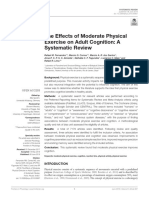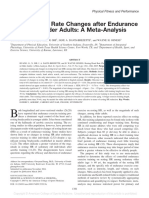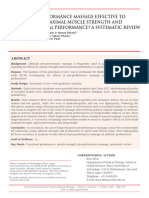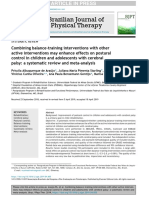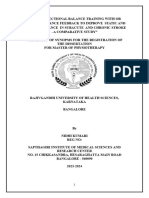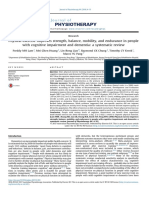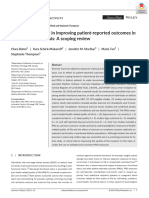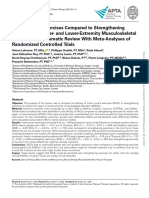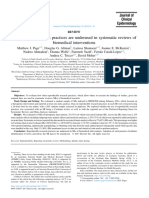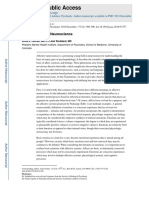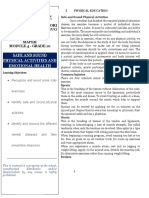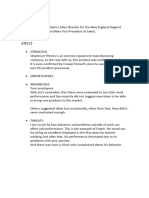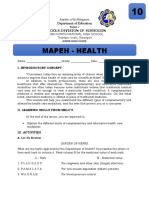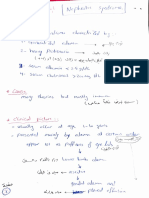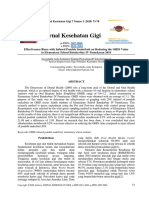2022 Effect of Muscle Strength Training in Children and Adolescents
2022 Effect of Muscle Strength Training in Children and Adolescents
Uploaded by
Kimum KimúmCopyright:
Available Formats
2022 Effect of Muscle Strength Training in Children and Adolescents
2022 Effect of Muscle Strength Training in Children and Adolescents
Uploaded by
Kimum KimúmOriginal Title
Copyright
Available Formats
Share this document
Did you find this document useful?
Is this content inappropriate?
Copyright:
Available Formats
2022 Effect of Muscle Strength Training in Children and Adolescents
2022 Effect of Muscle Strength Training in Children and Adolescents
Uploaded by
Kimum KimúmCopyright:
Available Formats
HHS Public Access
Author manuscript
Clin Rehabil. Author manuscript; available in PMC 2022 November 07.
Author Manuscript
Published in final edited form as:
Clin Rehabil. 2022 January ; 36(1): 4–14. doi:10.1177/02692155211040199.
Effect of muscle strength training in children and adolescents
with spastic cerebral palsy: A systematic review and meta-
analysis
Javier Merino-Andrés1,2,3, Agustín García de Mateos-López4, Diane L Damiano5, Alberto
Sánchez-Sierra2,3,6,7
1PedPT Research Lab, Toledo, Spain
Author Manuscript
2Faculty of Physiotherapy and Nursing, Universidad de Castilla-La Mancha, Toledo, Spain
3ToledoPhysiotherapy Research Group (GIFTO), Department of Nursing, Physical Therapy and
Occupational Therapy, Castilla-La Mancha University, Toledo, Spain
4Sanus Fisioterapia, Ciudad Real, Spain
5Rehabilitation Medicine Department, National Institutes of Health, Bethesda, MD, USA
6Department of Physiotherapy, Camilo Jose Cela University, Madrid, Spain
7Department of Physiotherapy, European University, Madrid, Spain
Abstract
Author Manuscript
Objective: This systematic review and meta-analysis investigates the effects of strength training
program in children and adolescents with cerebral palsy to improve function, activity, and
participation.
Data sources: Five electronic databases (MEDLINE-Pubmed, Cochrane Library, PEDro,
CINAHL, and SPORTDiscus) were systematically searched for full-text articles published from
inception to 30 June 2021.
Review methods: Randomized controlled trials were included, who compared: (i) child
population with spastic cerebral palsy population between 0 and 22 years; (ii) studies in which
a muscle strength training program was performed and included dosing information; (iii) studies
comparing strength training with other physical therapy technique(s) or untreated control group.
Author Manuscript
Article reuse guidelines: sagepub.com/journals-permissions
Corresponding author: Agustín García de Mateos-López, Sanus Fisioterapia, C/Alcántara n° 5, Ciudad Real 13004, Spain.
agustingml1998@gmail.com.
Author contributions
Conception and design: AGM-L and AS-S. Collection and assembly of data: AGM-L and JM-A. Analysis and interpretation of data:
All authors. Drafting of the article: All authors. Critical revision of the article for important intellectual content: JM-A and DM. All
authors take responsibility for the integrity of that data analysis.
PROSPERO database, registration number ID
CRD42020193535.
Declaration of conflicting interests
The author(s) declared no potential conflicts of interest with respect to the research, authorship, and/or publication of this article.
Supplemental material
Supplemental material for this article is available online.
Merino-Andrés et al. Page 2
Studies with similar outcomes were pooled by calculating standardized mean differences. Risk
Author Manuscript
of bias was assessed with Cochrane Collaboration’s tool for assessing the risk of bias and
PROSPERO’s registration number ID: CRD42020193535.
Results: Twenty-seven studies, comprising 847 participants with spastic cerebral palsy. The
meta-analyses demonstrated significant standardized mean differences in favor of strength training
program compared to other physical therapy technique(s) or untreated control group(s) for muscle
strength at the knee flexors, at the knee extensor, at the plantarflexors, maximum resistance,
balance, gait speed, GMFM (global, D and E dimension) and spasticity.
Conclusion: A strength training program has positive functional and activity effects on muscle
strength, balance, gait speed, or gross motor function without increasing spasticity for children and
adolescents with cerebral palsy in Gross Motor Function Classification System levels I, II, and III
when adequate dosage and specific principles are utilized.
Author Manuscript
Keywords
Cerebral palsy; meta-analysis; strengthening; systematic review; pediatric
Introduction
Based on the systematic review of the evidence for all interventions in cerebral palsy
by Novak et al.,1 physical training has demonstrated positive effects on muscle strength,2
aerobic capacity,2 and energy expenditure (reducing sedentary lifestyle).1 The types of
effects seen may depend on the dose and training parameters performed in order to target
certain objectives. In their review, muscle strengthening was shown to improve fitness,
physical activity, ambulation, mobility, participation, and quality of life, but it is necessary
Author Manuscript
to combine this with other intervention to achieve a positive effect on functional mobility or
other gross motor skills.1
Muscle strengthening has been studied by various authors with inconsistent conclusions
across studies, such as some state that muscle strength improves but not function, or
that the results should be taken with caution;3 while other authors report that there is an
improvement in motor activity4,5 and in specific functions such as gait.5,6 Finally, there
is another group of studies reporting no benefit of any kind both for strengthening of
the muscle groups of the lower7 and upper limbs.8 Most if not all authors conclude that
there is the need for more research and a higher level of evidence to be able to determine
the functional benefits of muscle strengthening in children and adolescents with cerebral
palsy.3–8
Author Manuscript
Therefore our objective was to review the most current scientific evidence on strength
training in children and adolescents with cerebral palsy, due to an increase in the number
of clinical studies since the last systematic review in 2014. It is a recommended practice
to update evidence reviews or guidelines every 3–5 years. Our focus was on the effects of
strength training on function, activity, and participation and on providing insights on the
dosing parameters and training strategies that are associated with more positive results, in
terms of strength, gait, balance, function, or spasticity.
Clin Rehabil. Author manuscript; available in PMC 2022 November 07.
Merino-Andrés et al. Page 3
Methodology
Author Manuscript
Before starting, this review was registered in the PROSPERO database (registration number
ID: CRD42020193535). The recommendations and the checklist of the Preferred Reporting
Elements for Systematic Reviews and Meta-Analysis (PRISMA)9 were followed for its
development.
Search strategy
Systematic searches were conducted in MEDLINE (PubMed), PEDro, Cochrane Library,
CINAHL, and SPORTDiscus. From inception to 30 June 2021 searches were conducted for
randomized trials comparing the effects of strength training with other types of interventions
or no intervention. Search terms included specific terms such as “cerebral palsy,” strength
training,” “strength exercise,” “resistance training,” “children,” “young,” “adolescent,”
“infant,” “pediatric,” and “spastic.” The search strategy for the different databases is shown
Author Manuscript
in Table A1 of the Supplemental Appendix. To complete the systematic literature search, the
references of eligible articles were examined; where articles were first selected by keywords,
then by title and abstract; the last step being the full text reading.
Study selection
The included studies had to meet the following inclusion criteria: (i) child population with
spastic cerebral palsy; (ii) cerebral palsy population between 0 and 22 years old; (iii)
randomized clinical trials; (iv) studies in which a muscle strength training program was
performed and included dosing information. These studies could involve strength training of
a single body segment or one or more limbs or larger body regions; (v) studies comparing
strength training with other physical therapy technique(s) or untreated control group; (vi) no
language restrictions.
Author Manuscript
The exclusion criteria for the studies were the following: (i) studies where strength
training is combined with aerobic training; (ii) studies that combined strength training
with botulinum toxin type A treatment or any type of medical-surgical intervention (with a
minimum of six months of application); (iii) not randomized clinical trials; and (iv) studies
that do not specify the strength training dose.
Data extraction and risk of bias assessment
Data extraction was done by two investigators and they created a table summarizing the
following information from the studies: (1) author; (2) country; (3) year of publication;
(4) characteristics of the sample (sample size, distribution by age, and type of population);
(5) dose of the intervention; (6) type of force intervention; (7) measured variables; and
Author Manuscript
(8) comparison groups. The Cochrane Collaboration’s tool for assessing risk of bias
(RoB2)10 was used to assess the risk of bias of the included randomized clinical trials.
Assessment with this tool includes six domains: randomization process, deviations from
planned interventions, missing outcome data, outcome measurement, and reported outcome
selection. Each domain can be scored as: low risk of bias, some concerns, or high risk of
bias. The literature search, data extraction, and quality assessment were performed by two
independent reviewers, and a third reviewer was included when inconsistencies remained.
Clin Rehabil. Author manuscript; available in PMC 2022 November 07.
Merino-Andrés et al. Page 4
Assessment of methodological quality
Author Manuscript
The reviewed studies were composed of randomized clinical trials. Therefore, GRADE
(Grading of Recommendations Assessment, Development, and Evaluation) scores were
calculated to estimate the methodological quality of these studies. Randomized clinical
trials are controlled study designs known to minimize the risk of bias. The GRADEpro
application,11 whose utility has been approved, was used. The GRADE scale rates the level
of evidence of the results, taking into account aspects related to the methodology and results
of the study, such as (1) risk of bias, (2) inconsistency, (3) indirect evidence, (4) imprecision,
and (5) other considerations (dose-response and reported biases).
Statistical analysis and data synthesis
To calculate the pooled estimate of the effect size and confidence intervals (CI) of 95%
used the method DerSimonian and Kacker,12 using random effects models. A standardized
Author Manuscript
mean difference score was calculated for each subgroup, using the Hedges g-index as the
effect size statistic, in which negative effect size values indicate a positive effect of specific
strength training versus the control group or another intervention, for the improvement
of each variable. Hedges g values represented the following: (i) weak effects when the
values were around 0.2, (ii) moderate effects when the values were around 0.5, (iii) strong
effects when the values were around 0.8, and (iv) very strong effects when the values
were greater than 1.0.13 Heterogeneity of results between studies was assessed using the
I2 statistic. The I2 values were interpreted as: may not be important (0%–40%); may
represent moderate heterogeneity (30%–60%); substantial heterogeneity (50%–90%); or
considerable heterogeneity (75%–100%). Values with statistical significance set at P < 0.10
were also considered. These statistical calculations were performed as long as there were a
minimum of four studies reporting data on the same outcome and the data were valid for
Author Manuscript
meta-analysis. The software Comprehensive Meta-Analysis version 2.0 software (Biostat,
Englewood, NJ, USA) for the statistical analyzes was used.
Results
Systematic review
Twenty-seven studies14–40 (Figure 1) analyzed the influence of muscle strength training in
children and adolescents with spastic cerebral palsy. A total of 873 subjects participated
in the analyzed studies, of which 847 were diagnosed with spastic cerebral palsy and 26
subjects with no diagnosis of neurological impairments.14,32 The age range was between
3 and 22 years. The subjects were divided into unilateral spastic (221 subjects) and
bilateral (517 subjects) cerebral palsy, while the distribution in the Gross Motor Function
Author Manuscript
Classification System levels of the studies that reported these data was 147 in level I, 170 in
level II, 106 at level III, and 9 at level IV, (not all datas were reported). Of the total sample of
children with diagnosed with spastic cerebral palsy, strength training was performed by 452
participants (Table A2 in the Supplemental Appendix).
The results of assessment of the strength of the evidence in references are shown in Table A3
in the Supplemental Appendix.
Clin Rehabil. Author manuscript; available in PMC 2022 November 07.
Merino-Andrés et al. Page 5
Of the 27 studies, 15 performed strength training in a clinical physiotherapy session, 8 were
Author Manuscript
done in the natural environment of the home and 4 in the school environment. The main
outcome variables evaluated were strength, spasticity, gait, balance, energy expenditure, and
motor function with some variation in the types of outcomes and how these were measured
across studies (Table A2 in the Supplemental Appendix).
Of the 27 studies, 22 reported measures of muscle strength in various muscles and using
a range of methods. At the knee joint, the strength of the extensors was measured in 15
studies and of the flexors in 10 studies. At the hip joint, the strength of the flexors was
measured in five studies, of the extensors in four studies; and of the abductors in six
studies. Finally, at the ankle, plantarflexors strength was measured in five studies and of the
dorsiflexors in three studies. The global strength of the lower limbs was measured in four
studies. Maximum resistance was measured by one-repetition maximum in six studies and
by six-repetitions maximum were measured in two studies. Others strength measures were
Author Manuscript
anaerobic muscle power and muscle power sprint.
With respect to gross motor function, 15 studies measured this outcome using the Gross
Motor Function Measure (GMFM). Ten studies studied the D dimension; 11 studied the E
dimension. The sum of dimensions D and E only was measured in three studies, the total
GMFM Score in seven studies. GMFM-88 was used mostly while GMFM-66 was used in
four studies.
Regarding strength training and their characteristics, results varied across studies. With
regards to the training dose, programs lasted between 4 and 12 weeks (short-term effects),
with exercises carried out between 2 and 5 days a week, for a duration ranging from 20 to
60 minutes. Each exercise had between 3 and 20 repetitions with 1 or 3 series of repetitions.
Author Manuscript
In addition, these exercises were usually performed without resistance or with the use of
specific equipment such as balls, weight machines, backpacks, cuff weights, body vests, or
sand bags, (Table A4 in the Supplemental Appendix).
With respect to gait parameters, 13 measured temporal-spatial parameters such as speed with
cadence and stride length parameters additionally reported in four trials.
Notably, eight trials measured balance with three studies utilizing the Timed Up and Go test,
two with the Pediatric Berg Balance Scale, one with the Bruininks Oseretsky Test of Motor
Proficiency, one with Biodex Balance System Test, and one with the Functional Reach Test.
Seven studies measured spasticity. Four of them through the modified Ashworth scale and
three through the presence of a spastic catch in a rapid stretch of the lower limb musculature.
Author Manuscript
All studies demonstrated that strength training did not change or have adverse effects on
spasticity, (Table A2 in the Supplemental Appendix).
Finally, the following secondary outcomes were also reported in various studies: ability
to climb stairs (Timed Stair Test), symmetric weight bearing capacity, morphological
properties of the muscle (cross-sectional area), participation, quality of life, attainment of
individualized goals, and satisfaction with the level of attainment (Canadian Occupational
Clin Rehabil. Author manuscript; available in PMC 2022 November 07.
Merino-Andrés et al. Page 6
Performance Measure), self-concept, activities of daily living, Sit to Stand and Lateral Step
Author Manuscript
up and energy expenditure (beats/minute and Net Nondimensional oxygen cost – NNcost.
Risk of bias
For randomized clinical trials conducted by intention to treat and assessed with the Cochrane
Collaboration’s tool for assessing risk of bias (RoB2), 100% of the studies show a low
risk of bias, with a total of three studies in this risk of bias assessment group (Figure A1
in the Supplemental Appendix). For randomized clinical trials performed by protocol and
evaluated with Cochrane Collaboration’s tool for assessing risk of bias (RoB2), 4.2% studies
show a low risk of bias, 62.5% studies show some concerns with the risk of bias and 33.3%
of studies demonstrated at least one high risk of bias category (mainly due to the evaluation
process, the randomization process or not being able to blind the interventions to the target
population), with a total of 24 studies in this risk of bias assessment group (Figure A1 in the
Author Manuscript
Supplemental Appendix).
Meta-analyses grouped by outcome measures
Of the 27 studies included in the qualitative synthesis, 24 studies were used, since three
were excluded because they did not report data that could be analyzed.18,32,35 We also did
not include studies that presented data on the same sample already reported to prevent a
replication bias as in the studies by Scholtes et al.30,31
Muscle strength at the knee joint
Figure A2 of the Supplemental Appendix summarizes the six trials evaluating the effects
of strength training compared to other interventions for increasing muscle strength of
the knee flexors, which showed a small but greater positive effect, but with considerable
Author Manuscript
heterogeneity. The Figure A3 in Supplemental Appendix summarizes the 11 trials evaluating
the increase in muscle strength of the knee extensors which minimal positive effects in favor
of the strengthening with no heterogeneity.
Plantarflexors muscle strength
Figure A4 of the Supplemental Appendix summarizes the four trials evaluating the effects
of strength training compared to other interventions for increasing muscle strength of the
plantarflexors, which showed a small to moderate positive effect, but with substantial
heterogeneity.
Maximum resistance
Regarding maximum resistance, Figure A5 of Supplemental Appendix summarizes the
Author Manuscript
seven trials evaluating maximal force specifically, which show a small to moderate effect
with moderate heterogeneity for strengthening versus comparators for improving resistance
maximum.
Clin Rehabil. Author manuscript; available in PMC 2022 November 07.
Merino-Andrés et al. Page 7
Balance
Author Manuscript
The Figure A6 in Supplemental Appendix summarizes the eight trials evaluating strength
training force specifically, being more effective than other interventions to improve standing
balance; with an effect very strong effect with substantial heterogeneity.
Gait speed
Regarding the variable gait speed, Figure A7 of the Supplemental Appendix summarizes
the 13 trials evaluating training force specifically, which exhibits a small effect with no
heterogeneity compared to other interventions.
GMFM
The Figure 2 summarizes the five trials evaluating strength training specifically with respect
to other interventions for improving the GMFM scores, presenting a small but positive
Author Manuscript
effect without heterogeneity. The Figure 3 summarizes the trials evaluating strength training
specifically regarding the other interventions for improving the GMFM dimension D (9
trials) and for Dimension E (10 trials) (Figure 4), showing a small positive effect and no
heterogeneity for both dimensions.
Spasticity
Regarding the variable spasticity, Figure A8 of the Supplemental Appendix summarizes the
four trials evaluating training force specifically, which exhibits a small to moderate effect
with no heterogeneity compared to other interventions.
Discussion
Author Manuscript
The results from this review indicate a weak effect on the strength of the knee flexors and
extensors, in addition to the plantar flexors. They further demonstrated an increase in gait
speed and gross motor function, without increasing spasticity; through the implementation
of strength programs for children and adolescents with cerebral palsy. These findings
indicate an increase in the strength of the muscle groups of the lower extremities, which
implies the possibility of improving the workload capacity and the resistance of said
muscles, which are weak due to the neurological injury and resultant decreased activity.
In addition, the speed of walking is increased, which implies that children and adolescents
will be able to have better functional mobility. Also, gross motor function, that is, the ability
of each individual to perform certain voluntary movements and tasks (e.g. run or jump), is
increased. Finally, a large effect was obtained in terms of improvement in balance.
One of the most important results of this research is that strength training does not change or
Author Manuscript
have adverse effects on spasticity; with some authors providing data showing no worsening
of spasticity; while other authors merely state at the outset that spasticity will not be
increased by strength training.
Based on the Quality of Evidence Assessment, a strong recommendation is made for
improving the knee extensors muscle strength, gait speed, dimension E of the GMFM,
and for not increasing spasticity. In addition, a moderate recommendation is made for the
Clin Rehabil. Author manuscript; available in PMC 2022 November 07.
Merino-Andrés et al. Page 8
improvement of the knee flexors muscle strength, the total score and the score of dimension
Author Manuscript
D of the GMFM. In contrast, there is a weak recommendation for the improvement of
plantarflexors muscle strength, maximum resistance and balance.
Our results are in line with those made by Dodd et al.,4 where significant results were
obtained for the strength and function variables, but not for activity or participation. In
relation to Mockford and Caulton,6 positive effects were also similar to ours in terms of
function and gait, but the studies included in their review were not of as high a level of
evidence. Finally, the publication by Park and Kim5 obtained positive effects for gait and
strength in randomized clinical trials where all cerebral palsy ages were included: on the
other hand, our results are in contradiction to those obtained by Scianni et al.;7 where these
researchers concluded that strength training does not have positive effects on any variable in
the cerebral palsy population. Our results on spasticity are similar that obtained by Dodd et
al.,4 Mockford and Caulton,6 and Scianni et al.7 reporting no adverse effects from strength
Author Manuscript
training in cerebral palsy.
The results for the specific domains of the International Classification of Functioning,
Disability, and Health show an improvement in different aspects related to structure and
function, such as energy expenditure during walking, improvement in balance, joint ranges,
and the lack of increase in spasticity. Within the activity domain, a favorable result has
been obtained for the first time from a systematic Review on strength training programs
in children and adolescents with cerebral palsy, shown here by a positive effect on GMFM
scores, especially in the GMFM domains on standing, and walking, running and jumping.
In addition, improvements were also obtained in increased the distance walked per unit of
time, which again indicates an improvement in the ability to walk. Regarding participation,
the results found are inconsistent since some studies do show benefits on this domain and
Author Manuscript
others do not, so more research is needed in terms of participation for strength training
programs, because it has been seen that certain interventions may have an improvement of
all the domains of the International Classification of Functioning, Disability and Health.41
When searching the literature on strength training programs for other neurological
pathologies, we found that for stroke,42 the evidence generally indicates that muscle
strengthening programs generate improvements in gait,42,43 muscle strength,42,44 muscle
function,42 postural control,42 balance,42 quality of life,42 and independence;42 without
increasing spasticity42 and improving activity.42,45 In addition, within this pathology,
improvements were found in in both the lower and upper extremities.42 However, some
studies still do not show improvements in certain aspects of gait and balance;44 and even
suggest that perhaps this should not be done during the first three months after stroke.46
Author Manuscript
For those with Parkinson’s disease we found that strength training programs can improve
muscular strength,47,48 balance,48 and some of the typical motor symptoms48 of this
pathology; but no improvement was obtained in terms of walking,48 the patients’ confidence
in balance,48 and their quality of life;48 compared with a control group or no intervention.48
But it is necessary to provide other types of interventions in order to complement and
improve the functionality of these patients,47 since by itself strengthening does not seem to
improve functional gait49 or balance.49
Clin Rehabil. Author manuscript; available in PMC 2022 November 07.
Merino-Andrés et al. Page 9
In summary strength training programs appear to improve the strength of trained muscles,
Author Manuscript
balance, gait, and motor function in CP; without increasing spasticity; but this type of
intervention may demonstrate different effects in different neurological conditions.
After the analysis of the different strength training protocols in this study (Table A4 in
the Supplemental Appendix) and the review of some guidelines about strength training in
children and adolescents,50 the minimum recommendations to obtain positive effects with
strength training in children and adolescents with cerebral palsy are summarized in Table A5
in the Supplemental Appendix.
Several limitations to this evidence summary were identified. (1) The assessment of risk
of bias showed that about half of the studies had some concerns or a moderate risk of
bias, while the other half of the studies showed a high risk of bias. It should be noted
that the main reasons behind the higher risk of bias in the included studies were errors
Author Manuscript
when evaluating the results and problems when blinding (which is possible to do with
blind assessors); while the main reason behind the moderate risk of bias studies was
certain deviations during the treatment period, due to the number of sample losses. (2)
The studies did not analyze follow-up or long-term effect. (3) The vast majority of studies
analyze the benefits of strength programs for lower limbs and trunk, where antigravity
strength is critically important for gross motor function and mobility; but little research has
been done on the benefits of training over upper limbs ( where coordination movements
are most important). (4) Despite the favorable result in terms of improved function with
strength training, more research is needed in this field, particularly on its potential effects on
participation, which has hardly been studied with respect to strength training programs. (5)
Future studies should analyze the effects of combining strength training and botulinum toxin
type A injections in antagonistic muscle pairs or strength training combined with task related
Author Manuscript
motor skill training. (6) The analyzed sample was from levels I, II, and III of the Gross
Motor Function Classification System, so the results cannot be extrapolated to levels IV
and V, (their motor control and involuntary movements may limit their ability to strengthen
specific muscles and to do it safely, so they may need to do it with others modalities such
as aquatic strengthening exercise or neuromuscular electrical stimulation). (7) Many of the
studies do not present a program structured according to the recommended exercise and
activity guidelines, which could influence the results of each of the studies,51 so both under
and over dosing can lead to poorer outcomes. (8) More research about strength training
programs and their effects in spasticity in a wider range of patients is needed.
Conclusions
In summary, our study shows that strength training in cerebral palsy subjects in the pediatric
Author Manuscript
and adolescents age group has positive effects in terms of muscle strength in lower limbs,
maximum work resistance, gait speed, and standing balance and gross motor function,
without affecting spasticity; but these positive effects have a short-term duration, making it
necessary for children with cerebral palsy to do high-intensity strength training regularly to
maintain and ideally accumulate benefits over time. Finally, strength training is only one
aspect of physical training and should be part of a larger program that includes task-related
motor skill training as well as endurance training for optimal results.
Clin Rehabil. Author manuscript; available in PMC 2022 November 07.
Merino-Andrés et al. Page 10
Supplementary Material
Author Manuscript
Refer to Web version on PubMed Central for supplementary material.
Funding
The author(s) received no financial support for the research, authorship, and/or publication of this article.
References
1. Novak I, Morgan C, Fahey M, et al. State of the evidence traffic lights 2019: systematic review of
interventions for preventing and treating children with cerebral palsy. Curr Neurol Neurosci Rep
2020; 20(2): 3. [PubMed: 32086598]
2. Novak I, McIntyre S, Morgan C, et al. A systematic review of interventions for children with
cerebral palsy: state of the evidence. Dev Med Child Neurol 2013; 55(10): 885–910. [PubMed:
23962350]
Author Manuscript
3. Darrah J, Fan JSW, Chen LC, et al. Review of the effects of progressive resisted muscle
strengthening in children with cerebral palsy: a clinical consensus exercise. Pediatr Phys Ther 1997;
9(1): 12–17.
4. Dodd KJ, Taylor NF and Damiano DL. A systematic review of the effectiveness of strength-
training programs for people with cerebral palsy. Arch Phys Med Rehabil 2002; 83(8): 1157–1164.
[PubMed: 12161840]
5. Park EY and Kim WH. Meta-analysis of the effect of strengthening interventions in individuals with
cerebral palsy. Res Dev Disabil 2014; 35(2): 239–249. [PubMed: 24291625]
6. Mockford M and Caulton JM. Systematic review of progressive strength training in children and
adolescents with cerebral palsy who are ambulatory. Pediatr Phys Ther 2008; 20(4): 318–333.
[PubMed: 19011522]
7. Scianni A, Butler JM, Ada L, et al. Muscle strengthening is not effective in children and
adolescents with cerebral palsy: a systematic review. Aust J Physiother 2009; 55(2): 81–87.
[PubMed: 19463078]
Author Manuscript
8. Rameckers EA, Janssen-Potten YJ, Essers IM, et al. Efficacy of upper limb strengthening in children
with cerebral palsy: a critical review. Res Dev Disabil 2015; 36C: 87–101. [PubMed: 25462469]
9. Page MJ, McKenzie JE, Bossuyt PM, et al. The PRISMA 2020 statement: an updated guideline for
reporting systematic reviews. BMJ 2021; 372: n71. [PubMed: 33782057]
10. Higgins JP, Sterne JA, Savovic J, et al. A revised tool for assessing risk of bias in randomized trials.
Cochrane Database Syst Rev 2016; 10(Suppl 1): 29–31.
11. Atkins D, Best D, Briss PA, et al. Grading quality of evidence and strength of recommendations.
BMJ 2004; 328(7454): 1490–1494. [PubMed: 15205295]
12. DerSimonian R and Kacker R. Random-effects model for meta-analysis of clinical trials: an
update. Contemp Clin Trials 2007; 28(2): 105–114. [PubMed: 16807131]
13. Cohen J Statistical power analysis for the behavioral sciences. 2nd ed. Hillsdale, NJ: L. Erlbaum
Associates, 1988.
14. Fowler EG, Ho TW, Nwigwe AI, et al. The effect of quadriceps femoris muscle strengthening
exercises on spasticity in children with cerebral palsy. Phys Ther 2001; 81(6): 1215–1223.
Author Manuscript
[PubMed: 11380277]
15. Dodd KJ, Taylor NF and Graham HK. A randomized clinical trial of strength training in young
people with cerebral palsy. Dev Med Child Neurol 2003; 45(10): 652–657. [PubMed: 14515935]
16. Park SI, Kim MS and Choi JD. Effects of concentric and eccentric control exercise on gross motor
function and balance ability of paretic leg in children with spastic hemiplegia. J Phys Ther Sci
2016; 28(7): 2128–2131. [PubMed: 27512281]
17. Unger M, Faure M and Frieg A. Strength training in adolescent learners with cerebral palsy: a
randomized controlled trial. Clin Rehabil 2006; 20(6): 469–477. [PubMed: 16892929]
Clin Rehabil. Author manuscript; available in PMC 2022 November 07.
Merino-Andrés et al. Page 11
18. Kruse A, Schranz C, Svehlik M, et al. The effect of functional home-based strength training
programs on the mechano-morphological properties of the plantar flexor muscle-tendon unit in
Author Manuscript
children with spastic cerebral palsy. Pediatr Exerc Sci 2019; 31(1): 67–76. [PubMed: 30424684]
19. Elnaggar RK, Elbanna MF, Mahmoud WS, et al. Plyometric exercises: subsequent changes of
weight-bearing symmetry, muscle strength and walking performance in children with unilateral
cerebral palsy. J Musculoskelet Neuronal Interact 2019; 19(4): 507–515. [PubMed: 31789302]
20. Kara OK, Livanelioglu A, Yardimci BN, et al. The effects of functional progressive strength and
power training in children with unilateral cerebral palsy. Pediatr Phys Ther 2019; 31(3): 286–295.
[PubMed: 31220015]
21. Nikolaos C, Emmanouil S, Eirini G, et al. The effect of a functional progressive strength training
program on mobility of ambulatory adolescents and young adults with cerebral palsy. Sport Med
Rehabil J 2019; 4(1): 1–7.
22. Ryan JM, Lavelle G, Theis N, et al. Progressive resistance training for adolescents with cerebral
palsy: the STAR randomized controlled trial. Dev Med Child Neurol 2020; 62: 1283–1293.
[PubMed: 32588919]
23. Cho H-J and Lee B-H. Effect of functional progressive resistance exercise on lower extremity
Author Manuscript
structure, muscle tone, dynamic balance and functional ability in children with spastic cerebral
palsy. Children 2020; 7(8): 85.
24. Liao HF, Liu YC, Liu WY, et al. Effectiveness of loaded sit-to-stand resistance exercise for
children with mild spastic diplegia: a randomized clinical trial. Arch Phys Med Rehabil 2007;
88(1): 25–31. [PubMed: 17207671]
25. Seniorou M, Thompson N, Harrington M, et al. Recovery of muscle strength following multi-level
orthopaedic surgery in diplegic cerebral palsy. Gait Posture 2007; 26(4): 475–481. [PubMed:
17855096]
26. Olama KA. Endurance exercises versus treadmill training in improving muscle strength and
functional activities in hemiparetic cerebral palsy. Egypt J Med Hum Genet 2011; 12(2): 193–199.
27. Lee JH, Sung IY and Yoo JY. Therapeutic effects of strengthening exercise on gait function of
cerebral palsy. Disabil Rehabil 2008; 30(19): 1439–1444. [PubMed: 19230216]
28. MacPhail HE and Kramer JF. Effect of isokinetic strength-training on functional ability and
walking efficiency in adolescents with cerebral palsy. Dev Med Child Neurol 1995; 37(9): 763–
775. [PubMed: 7589859]
Author Manuscript
29. Salem Y and Godwin EM. Effects of task-oriented training on mobility function in children with
cerebral palsy. NeuroRehabilitation 2009; 24: 307–313. [PubMed: 19597267]
30. Scholtes VA, Becher JG, Comuth A, et al. Effectiveness of functional progressive resistance
exercise strength training on muscle strength and mobility in children with cerebral palsy: a
randomized controlled trial. Dev Med Child Neurol 2010; 52(6): e107–e113. [PubMed: 20132136]
31. Scholtes VA, Becher JG, Janssen-Potten YJ, et al. Effectiveness of functional progressive
resistance exercise training on walking ability in children with cerebral palsy: a randomized
controlled trial. Res Dev Disabil 2012; 33(1): 181–188. [PubMed: 22093663]
32. Reid S, Hamer P, Alderson J, et al. Neuromuscular adaptations to eccentric strength training
in children and adolescents with cerebral palsy. Dev Med Child Neurol 2010; 52(4): 358–363.
[PubMed: 19737297]
33. Ali MS, Awad AS and Elassal MI. The effect of two therapeutic interventions on balance in
children with spastic cerebral palsy: a comparative study. J Taibah Univ Med Sci 2019; 14(4):
350–356. [PubMed: 31488967]
Author Manuscript
34. Mohamed AS, Kamal HM, Elsied AO, et al. Universal exercise unit versus functional resisted
training effect on muscle strength in spastic diaplegia. Indian J Public Health Res Dev 2020; 11:
1139–1144. DOI: 10.37506/ijphrd.v11i4.8748
35. Gates PE, Banks D, Johnston TE, et al. Randomized controlled trial assessing participation and
quality of life in a supported speed treadmill training exercise program vs. a strengthening program
for children with cerebral palsy. J Pediatr Rehabil Med 2012; 5(2): 75–88. [PubMed: 22699098]
36. Taylor NF, Dodd KJ, Baker RJ, et al. Progressive resistance training and mobility-related function
in young people with cerebral palsy: a randomized controlled trial. Dev Med Child Neurol 2013;
55: 806–812. [PubMed: 23789741]
Clin Rehabil. Author manuscript; available in PMC 2022 November 07.
Merino-Andrés et al. Page 12
37. Wang TH, Peng YC, Chen YL, et al. A home-based program using patterned sensory enhancement
improves resistance exercise effects for children with cerebral palsy: a randomized controlled trial.
Author Manuscript
Neurorehabil Neural Repair 2013; 27(8): 684–694. [PubMed: 23757295]
38. Bania TA, Dodd KJ, Baker RJ, et al. The effects of progressive resistance training on daily physical
activity in young people with cerebral palsy: a randomised controlled trial. Disabil Rehabil 2016;
38(7): 620–626. [PubMed: 26056856]
39. Tedla J Strength training effects on balance in spastic diplegia subjects: a randomized controlled
trial. J Pediatr Neurol 2014; 12(01): 015–028.
40. Kusumoto Y, Nitta O and Takaki K. Impact of loaded sit-to-stand exercises at different speeds
on the physiological cost of walking in children with spastic diplegia: a single-blind randomized
clinical trial. Res Dev Disabil 2016; 57: 85–91. [PubMed: 27394691]
41. Anaby D, Avery L, Gorter JW, et al. Improving body functions through participation in community
activities among young people with physical disabilities. Dev Med Child Neurol 2020; 62(5):
640–646. [PubMed: 31670397]
42. Veldema J and Jansen P. Resistance training in stroke rehabilitation: systematic review and meta-
analysis. Clin Rehabil 2020; 34(9): 1173–1197. [PubMed: 32527148]
Author Manuscript
43. Mehta S, Pereira S, Viana R, et al. Resistance training for gait speed and total distance walked
during the chronic stage of stroke: a meta-analysis. Top Stroke Rehabil 2012; 19(6): 471–478.
[PubMed: 23192712]
44. Wist S, Clivaz J and Sattelmayer M. Muscle strengthening for hemiparesis after stroke: a meta-
analysis. Ann Phys Rehabil Med 2016; 59(2): 114–124. [PubMed: 26969343]
45. Dorsch S, Ada L and Alloggia D. Progressive resistance training increases strength after stroke
but this may not carry over to activity: a systematic review. J Physiother 2018; 64(2): 84–90.
[PubMed: 29602748]
46. Salter K, Musovic A and F Taylor N. In the first 3 months after stroke is progressive resistance
training safe and does it improve activity? A systematic review. Top Stroke Rehabil 2016; 23(5):
366–375. [PubMed: 27077991]
47. Roeder L, Costello JT, Smith SS, et al. Effects of resistance training on measures of muscular
strength in people with Parkinson’s disease: a systematic review and meta-analysis. PLoS One
2015; 10(7): e0132135. [PubMed: 26146840]
Author Manuscript
48. Chung CL, Thilarajah S and Tan D. Effectiveness of resistance training on muscle strength and
physical function in people with Parkinson’s disease: a systematic review and meta-analysis. Clin
Rehabil 2016; 30(1): 11–23. [PubMed: 25691582]
49. Saltychev M, Bärlund E, Paltamaa J, et al. Progressive resistance training in Parkinson’s disease: a
systematic review and meta-analysis. BMJ Open 2016; 6(1): e008756.
50. Faigenbaum AD, Kraemer WJ, Blimkie CJ, et al. Youth resistance training: updated position
statement paper from the National Strength and Conditioning Association. J Strength Cond Res
2009; 23(5 Suppl): S60–S79. [PubMed: 19620931]
51. Maltais DB, Wiart L, Fowler E, et al. Health-related physical fitness for children with cerebral
palsy. J Child Neurol 2014; 29(8): 1091–1100. [PubMed: 24820339]
Author Manuscript
Clin Rehabil. Author manuscript; available in PMC 2022 November 07.
Merino-Andrés et al. Page 13
Clinical messages
Author Manuscript
• Strength training programs resulted in gains in muscle strength, maximum
resistance, balance, gait, and gross motor function in children and adolescents
with cerebral palsy without effects on spasticity.
• Strength training programs improved structure, function and activity in
International Classification of Functioning, Disability, and Health domains,
but did not improve the participation domain.
• More research is needed on strength training programs in pediatric
neurological conditions.
Author Manuscript
Author Manuscript
Author Manuscript
Clin Rehabil. Author manuscript; available in PMC 2022 November 07.
Merino-Andrés et al. Page 14
Author Manuscript
Author Manuscript
Figure 1.
Flowchart of included studies.
Author Manuscript
Author Manuscript
Clin Rehabil. Author manuscript; available in PMC 2022 November 07.
Merino-Andrés et al. Page 15
Author Manuscript
Figure 2.
Author Manuscript
Forest plots of pooled effect size for GMFM total score improvement.
Author Manuscript
Author Manuscript
Clin Rehabil. Author manuscript; available in PMC 2022 November 07.
Merino-Andrés et al. Page 16
Author Manuscript
Author Manuscript
Figure 3.
Forest plots of pooled effect size for GMFM dimension D score improvement.
Author Manuscript
Author Manuscript
Clin Rehabil. Author manuscript; available in PMC 2022 November 07.
Merino-Andrés et al. Page 17
Author Manuscript
Author Manuscript
Figure 4.
Forest plots of pooled effect size for GMFM dimension E score improvement.
Author Manuscript
Author Manuscript
Clin Rehabil. Author manuscript; available in PMC 2022 November 07.
You might also like
- Antifoam UCARSOL GT900EDocument10 pagesAntifoam UCARSOL GT900Emahdi rasoulianNo ratings yet
- SDS - Vacuum Pump OilDocument5 pagesSDS - Vacuum Pump Oilmeor azrieNo ratings yet
- 10.1.1.881.8683Document13 pages10.1.1.881.8683vladNo ratings yet
- The SCI Exercise Self-Efficacy Scale (ESES) : Development and Psychometric PropertiesDocument6 pagesThe SCI Exercise Self-Efficacy Scale (ESES) : Development and Psychometric PropertiesInês SacaduraNo ratings yet
- Fernandes, 2018 PDFDocument11 pagesFernandes, 2018 PDFCarlos CarlitosNo ratings yet
- Fernandes, 2018 PDFDocument11 pagesFernandes, 2018 PDFCarlos CarlitosNo ratings yet
- Evidence Based TableDocument13 pagesEvidence Based Tableneometal_86No ratings yet
- Huang 2005Document6 pagesHuang 2005kedjadjasalim9No ratings yet
- Brain GymDocument6 pagesBrain GymAula reciNo ratings yet
- Advantages of Virtual Reality in The Rehabilitation PDFDocument10 pagesAdvantages of Virtual Reality in The Rehabilitation PDFAlexNo ratings yet
- Pilates Exercise and Functional Balance in Parkinson's DiseaseDocument14 pagesPilates Exercise and Functional Balance in Parkinson's DiseaseBlandina HelenaNo ratings yet
- Goodwin Et Al-2008-Movement DisordersDocument10 pagesGoodwin Et Al-2008-Movement DisordersyuliatinnisaNo ratings yet
- 10.1093 PTJ Pzac153Document13 pages10.1093 PTJ Pzac153evelyn.minichNo ratings yet
- Efects of Inspiratory Muscle Training in Older AdultsDocument10 pagesEfects of Inspiratory Muscle Training in Older AdultsMaría Camila Zuluaga AriasNo ratings yet
- Physical Exercise For Individuals With Spinal Cord Injury SystematicDocument12 pagesPhysical Exercise For Individuals With Spinal Cord Injury SystematicReagir ReagirNo ratings yet
- FitnessDocument32 pagesFitnessFernanda LopezNo ratings yet
- Neural Plasticity - 2020 - Johansson - Exercise Induced Neuroplasticity in Parkinson S Disease A Metasynthesis of TheDocument15 pagesNeural Plasticity - 2020 - Johansson - Exercise Induced Neuroplasticity in Parkinson S Disease A Metasynthesis of Therazznotrizz09No ratings yet
- Ijerph 19 08212 v3Document16 pagesIjerph 19 08212 v3SAMARIA RAQUEL ESQUIVEL RINCONNo ratings yet
- The Impact of Physical Activity On Brain Structure and Function in Youth - A Systematic ReviewDocument17 pagesThe Impact of Physical Activity On Brain Structure and Function in Youth - A Systematic ReviewSơn Đoàn TrungNo ratings yet
- Comparison Between Task Oriented TraininDocument9 pagesComparison Between Task Oriented TrainingcabanNo ratings yet
- ptrs009 01 08Document11 pagesptrs009 01 08mohamedsalahudeen193No ratings yet
- Plyometric Training Effectiveness and Optimal.3Document11 pagesPlyometric Training Effectiveness and Optimal.3LeonardoValenzuelaNo ratings yet
- Effect of Cardiorespiratory Training On Aerobic Fitness and Carryover To Activity in Children With Cerebral Palsy: A Systematic ReviewDocument7 pagesEffect of Cardiorespiratory Training On Aerobic Fitness and Carryover To Activity in Children With Cerebral Palsy: A Systematic Reviewalone94201314No ratings yet
- JPSP - 2022 - 50Document11 pagesJPSP - 2022 - 50İpek OMURNo ratings yet
- The Effects of Whole Body Vibration On Mobility and Balance in Children With Cerebral Palsy: A Systematic Review With Meta-AnalysisDocument8 pagesThe Effects of Whole Body Vibration On Mobility and Balance in Children With Cerebral Palsy: A Systematic Review With Meta-AnalysisMaria Camila SanabriaNo ratings yet
- Bar-Haim Et Al-2006-Developmental Medicine & Child NeurologyDocument6 pagesBar-Haim Et Al-2006-Developmental Medicine & Child NeurologyGiancarlo Becerra BravoNo ratings yet
- Cognitive Enhancement Strategies For Older Adults An Evaluation of Different Training Modalities To Improve Executive Function-A Systematic Review and Meta-AnalysisDocument11 pagesCognitive Enhancement Strategies For Older Adults An Evaluation of Different Training Modalities To Improve Executive Function-A Systematic Review and Meta-AnalysisRobert CosttaNo ratings yet
- Exercise and Sleep: A Systematic Review of Previous Meta-AnalysesDocument11 pagesExercise and Sleep: A Systematic Review of Previous Meta-AnalysesAlexPsrNo ratings yet
- Gamiz Bermudez Et Al 2021 Corrective Exercise Based Therapy For Adolescent IdiopDocument12 pagesGamiz Bermudez Et Al 2021 Corrective Exercise Based Therapy For Adolescent IdiopalfianjuniorNo ratings yet
- Leal 2019Document6 pagesLeal 2019Erik ArturNo ratings yet
- Jump Rope Training For Health and Fitness in SchooDocument15 pagesJump Rope Training For Health and Fitness in Schoodani yusupNo ratings yet
- Massage Presport Effects Meta AnalysisDocument11 pagesMassage Presport Effects Meta Analysisanddee28No ratings yet
- 5 - Yadav Sunita. Correlation of Balance Tests Scores With Modified Physical Performance Test in Indian Community-Dwelling Older AdultsDocument19 pages5 - Yadav Sunita. Correlation of Balance Tests Scores With Modified Physical Performance Test in Indian Community-Dwelling Older AdultsDr. Krishna N. SharmaNo ratings yet
- Jurnal Fleksibility LansiaDocument31 pagesJurnal Fleksibility LansiaKurnia WibowoNo ratings yet
- Escala de Status de RecuperacaoDocument10 pagesEscala de Status de RecuperacaoAltair LopesNo ratings yet
- Lit Review 1Document6 pagesLit Review 1api-749269676No ratings yet
- Use of PNF in PT_WestwaterWood 2010Document7 pagesUse of PNF in PT_WestwaterWood 2010Mateja BrebenNo ratings yet
- Efectiveness StrengtheningDocument12 pagesEfectiveness Strengtheningshera firanaNo ratings yet
- Karenpalacios Annotatedbibliography Final 1 1Document8 pagesKarenpalacios Annotatedbibliography Final 1 1api-708959407No ratings yet
- The Systemic Effects of Blood Flow Restriction Training A Systematic ReviewDocument13 pagesThe Systemic Effects of Blood Flow Restriction Training A Systematic ReviewFederico BristotNo ratings yet
- Nihms 123440Document19 pagesNihms 123440Gabriel CostaNo ratings yet
- 55.literature Review About Neurodevelopmental Approaches-1Document37 pages55.literature Review About Neurodevelopmental Approaches-1Zeeshan AhmadNo ratings yet
- Brazilian Journal of Physical TherapyDocument11 pagesBrazilian Journal of Physical TherapyshodhgangaNo ratings yet
- Balance TrainingDocument12 pagesBalance TrainingMahdicheraghi100% (1)
- Nidhi Synopsis Changes-1Document16 pagesNidhi Synopsis Changes-1NidhiNo ratings yet
- 1 s2.0 S1836955317301467 MainDocument12 pages1 s2.0 S1836955317301467 MainNeyfer Henao RiveroNo ratings yet
- Ageing Research ReviewsDocument11 pagesAgeing Research ReviewsNicolas Ramírez VargasNo ratings yet
- Low-Level Phototherapy To Improve Exercise Capacity and MuscleDocument14 pagesLow-Level Phototherapy To Improve Exercise Capacity and Muscleeasyperformance96No ratings yet
- Applications of The Dose-Response For Muscular STRDocument10 pagesApplications of The Dose-Response For Muscular STRAlexandre FerreiraNo ratings yet
- Sdi 12806Document15 pagesSdi 12806adri20121989No ratings yet
- The Effects of Low-Intensity Multimodal Proprioceptive Exercise On Cognitive Function in Older AdultsDocument6 pagesThe Effects of Low-Intensity Multimodal Proprioceptive Exercise On Cognitive Function in Older AdultsginoNo ratings yet
- Journal of Science and Medicine in SportDocument6 pagesJournal of Science and Medicine in SportAlvaro FernandoNo ratings yet
- MRP PDFDocument6 pagesMRP PDFAfrizal BintangNo ratings yet
- Motor Control Vs Strength TrainingDocument11 pagesMotor Control Vs Strength Trainingccnkz222tcNo ratings yet
- Nazari 2019Document31 pagesNazari 2019cris.endo.ceNo ratings yet
- FatehDocument9 pagesFatehVIVEKNo ratings yet
- Effect of Action Observation Therapy inDocument33 pagesEffect of Action Observation Therapy inseroxat2005No ratings yet
- A Systematic Review of The Effectiveness of Core Stability Exercises in Patients With Non Specific Low Back PainDocument9 pagesA Systematic Review of The Effectiveness of Core Stability Exercises in Patients With Non Specific Low Back PainAbdul WahidNo ratings yet
- Senthilarticlein JCDRDocument4 pagesSenthilarticlein JCDRAnnisa KusumaNo ratings yet
- Wooten 2017 Meditação Propriocepção EquilíbrioDocument8 pagesWooten 2017 Meditação Propriocepção EquilíbrioMessias FilhoNo ratings yet
- Psychophysiological assessment of human cognition and its enhancement by a non-invasive methodFrom EverandPsychophysiological assessment of human cognition and its enhancement by a non-invasive methodNo ratings yet
- The Lactate Revolution: The Science Of Quantifying, Predicting, And Improving Human PerformanceFrom EverandThe Lactate Revolution: The Science Of Quantifying, Predicting, And Improving Human PerformanceNo ratings yet
- 2018 Reproductive - Practices Are Underused in Systematic ReviewsDocument11 pages2018 Reproductive - Practices Are Underused in Systematic ReviewsKimum KimúmNo ratings yet
- Los Adultos Con Parálisis Cerebral Requieren Atención Neurológica Continua Una Revisión SistemáticaDocument12 pagesLos Adultos Con Parálisis Cerebral Requieren Atención Neurológica Continua Una Revisión SistemáticaKimum KimúmNo ratings yet
- Effects of A Supported Speed Treadmill Training Exercise Program On Impairment and Function For Children With Cerebral PalsyDocument9 pagesEffects of A Supported Speed Treadmill Training Exercise Program On Impairment and Function For Children With Cerebral PalsyKimum KimúmNo ratings yet
- Multidimensional Resilience ChildrenDocument19 pagesMultidimensional Resilience ChildrenKimum KimúmNo ratings yet
- Neurociencia Clínica AfectivaDocument5 pagesNeurociencia Clínica AfectivaKimum KimúmNo ratings yet
- Alfabetización en Neurociencias de Los Profesores de Ciencias en Formación Neuromitos y Una Comprensión Profesional Del Aprendizaje y La MemoriaDocument16 pagesAlfabetización en Neurociencias de Los Profesores de Ciencias en Formación Neuromitos y Una Comprensión Profesional Del Aprendizaje y La MemoriaKimum KimúmNo ratings yet
- MINUES OF 4th MANAGING COMMITTEE Rev 2 26-2-2014Document5 pagesMINUES OF 4th MANAGING COMMITTEE Rev 2 26-2-2014ReddyNo ratings yet
- Care Map Template - FinalDocument6 pagesCare Map Template - FinalOcholi AttahNo ratings yet
- Grade-10 Module-4 MAPEHDocument8 pagesGrade-10 Module-4 MAPEHFerry May ManzonNo ratings yet
- StepSmart Fitness CaseDocument2 pagesStepSmart Fitness CaseScribdTranslationsNo ratings yet
- Psy 101 L 1 - 8 Imp McqsDocument5 pagesPsy 101 L 1 - 8 Imp Mcqsbc240200070ariNo ratings yet
- Health10 (Las#4)Document6 pagesHealth10 (Las#4)cheri elaineNo ratings yet
- Fragment Reattachment After Complicated Crown-Root Fractures of Anterior Teeth: A Systematic ReviewDocument16 pagesFragment Reattachment After Complicated Crown-Root Fractures of Anterior Teeth: A Systematic ReviewARUNA BharathiNo ratings yet
- Swot MerckDocument3 pagesSwot Mercktomassetya0% (1)
- J of Gastro and Hepatol - 2022 - Simadibrata - A Comparison of Efficacy and Safety of Potassium Competitive Acid BlockerDocument12 pagesJ of Gastro and Hepatol - 2022 - Simadibrata - A Comparison of Efficacy and Safety of Potassium Competitive Acid BlockeraskhaeraniNo ratings yet
- Nephrotic SyndromeDocument5 pagesNephrotic SyndromeMahmoud SalmanNo ratings yet
- UPAN Newsletter Volume 7 Number 11 - November 2020Document11 pagesUPAN Newsletter Volume 7 Number 11 - November 2020Utah Prisoner Advocate NetworkNo ratings yet
- Emergency Room Assessment Form: Best Eye Opening Best VerbalDocument2 pagesEmergency Room Assessment Form: Best Eye Opening Best Verbaleliza marie luisNo ratings yet
- The Testosterone Boosting Cure - How To Dramatically Boost Your Testosterone With With Amino Acids, Minerals & Supplements (PDFDrive)Document89 pagesThe Testosterone Boosting Cure - How To Dramatically Boost Your Testosterone With With Amino Acids, Minerals & Supplements (PDFDrive)Dewi TribuanaNo ratings yet
- Purposive Communication ParaphrasingDocument2 pagesPurposive Communication ParaphrasingLyth LythNo ratings yet
- Calm Bible Study GuidelinesDocument7 pagesCalm Bible Study GuidelinesLEANDRO LAHINDONo ratings yet
- Workout Plan in SwimmingDocument5 pagesWorkout Plan in SwimmingMa Sophia LimNo ratings yet
- 2nd Chakra: First Harmonic UniverseDocument2 pages2nd Chakra: First Harmonic Universedolunay1990No ratings yet
- Effects of The Agility Boot Camp With Cognitive Challenge (ABC-C) Exercise Program For Parkinson 'S DiseaseDocument8 pagesEffects of The Agility Boot Camp With Cognitive Challenge (ABC-C) Exercise Program For Parkinson 'S Diseasedr Harien LestariNo ratings yet
- Auto-Axcess E 675 DigitalDocument164 pagesAuto-Axcess E 675 DigitalweldtechNo ratings yet
- Dubai New DevelopmentsDocument121 pagesDubai New DevelopmentsDubai New DevelopmentsNo ratings yet
- Starting Strength: Eating Through The Sticking PointsDocument6 pagesStarting Strength: Eating Through The Sticking PointsHarley WalkerNo ratings yet
- Jurnal Kesehatan GigiDocument6 pagesJurnal Kesehatan Giginur rahmadaniNo ratings yet
- Alternative Medicine Magazine - February 2024 PDF Omega 3 Fatty Acid NutritionDocument1 pageAlternative Medicine Magazine - February 2024 PDF Omega 3 Fatty Acid NutritiondrewsavaNo ratings yet
- Work Method Statement: Activity Wms For Mivan Modification WorkDocument6 pagesWork Method Statement: Activity Wms For Mivan Modification WorkamolNo ratings yet
- SexualDocument4 pagesSexualbulletproofheebNo ratings yet
- Kushi Jelly Drinks 75G x12 Pack WoolworthsDocument1 pageKushi Jelly Drinks 75G x12 Pack Woolworthsabbyabby53No ratings yet
- M2 Session 4 Roles and Responsibilities of Key Actors in CCCMDocument46 pagesM2 Session 4 Roles and Responsibilities of Key Actors in CCCMbasiliortogononjrNo ratings yet
- Bill Gates Is Evil Hastag PDFDocument223 pagesBill Gates Is Evil Hastag PDFCOVID 19 CORONA VIRUS100% (1)




